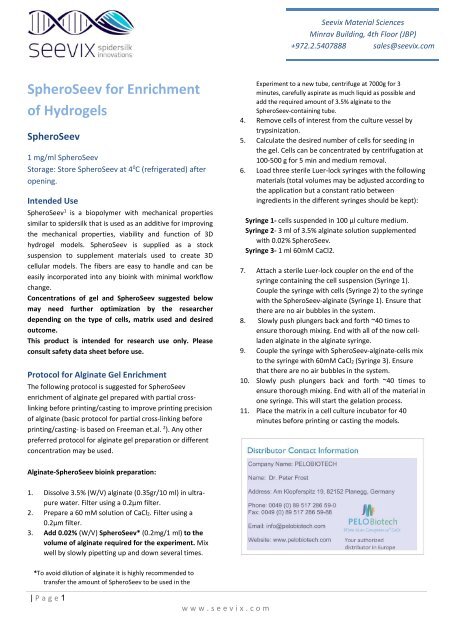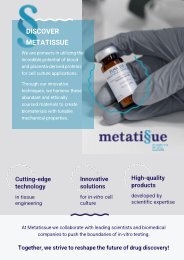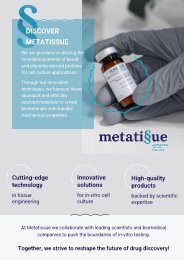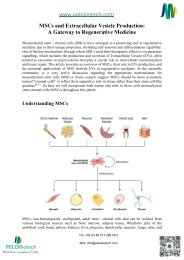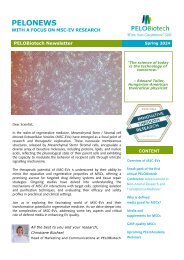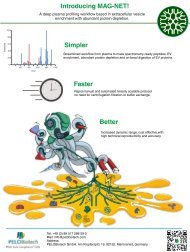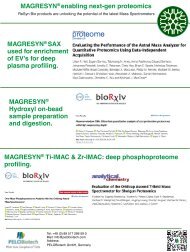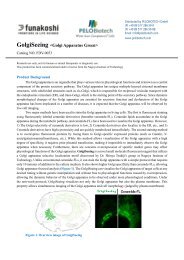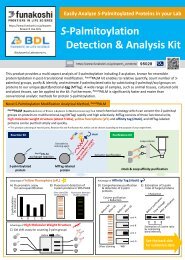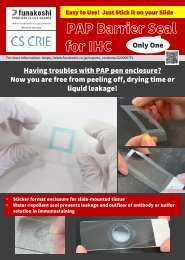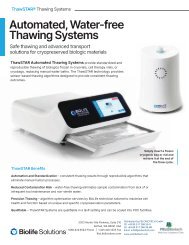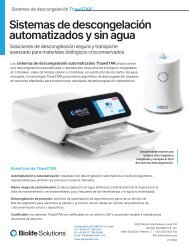SpheroSeev for Enrichment of Hydrogels
SpheroSeev1 is a biopolymer with mechanical properties similar to spidersilk that is used as an additive for improving the mechanical properties, viability, and function of 3D hydrogel models. SpheroSeev is supplied as a stock suspension to supplement materials used to create 3D cellular models. The fibers are easy to handle and can be easily incorporated into any bioink with minimal workflow change.
SpheroSeev1 is a biopolymer with mechanical properties similar to spidersilk that is used as an additive for improving the mechanical properties, viability, and function of 3D hydrogel models. SpheroSeev is supplied as a stock suspension to supplement materials used to create 3D cellular models. The fibers are easy to handle and can be easily incorporated into any bioink with minimal workflow change.
You also want an ePaper? Increase the reach of your titles
YUMPU automatically turns print PDFs into web optimized ePapers that Google loves.
Seevix Material Sciences<br />
Minrav Building, 4th Floor (JBP)<br />
+972.2.5407888 sales@seevix.com<br />
<strong>SpheroSeev</strong> <strong>for</strong> <strong>Enrichment</strong><br />
<strong>of</strong> <strong>Hydrogels</strong><br />
<strong>SpheroSeev</strong><br />
1 mg/ml <strong>SpheroSeev</strong><br />
Storage: Store <strong>SpheroSeev</strong> at 4 0 C (refrigerated) after<br />
opening.<br />
Intended Use<br />
<strong>SpheroSeev</strong> 1 is a biopolymer with mechanical properties<br />
similar to spidersilk that is used as an additive <strong>for</strong> improving<br />
the mechanical properties, viability and function <strong>of</strong> 3D<br />
hydrogel models. <strong>SpheroSeev</strong> is supplied as a stock<br />
suspension to supplement materials used to create 3D<br />
cellular models. The fibers are easy to handle and can be<br />
easily incorporated into any bioink with minimal workflow<br />
change.<br />
Concentrations <strong>of</strong> gel and <strong>SpheroSeev</strong> suggested below<br />
may need further optimization by the researcher<br />
depending on the type <strong>of</strong> cells, matrix used and desired<br />
outcome.<br />
This product is intended <strong>for</strong> research use only. Please<br />
consult safety data sheet be<strong>for</strong>e use.<br />
Protocol <strong>for</strong> Alginate Gel <strong>Enrichment</strong><br />
The following protocol is suggested <strong>for</strong> <strong>SpheroSeev</strong><br />
enrichment <strong>of</strong> alginate gel prepared with partial crosslinking<br />
be<strong>for</strong>e printing/casting to improve printing precision<br />
<strong>of</strong> alginate (basic protocol <strong>for</strong> partial cross-linking be<strong>for</strong>e<br />
printing/casting- is based on Freeman et.al. 2 ). Any other<br />
preferred protocol <strong>for</strong> alginate gel preparation or different<br />
concentration may be used.<br />
Experiment to a new tube, centrifuge at 7000g <strong>for</strong> 3<br />
minutes, carefully aspirate as much liquid as possible and<br />
add the required amount <strong>of</strong> 3.5% alginate to the<br />
<strong>SpheroSeev</strong>-containing tube.<br />
4. Remove cells <strong>of</strong> interest from the culture vessel by<br />
trypsinization.<br />
5. Calculate the desired number <strong>of</strong> cells <strong>for</strong> seeding in<br />
the gel. Cells can be concentrated by centrifugation at<br />
100-500 g <strong>for</strong> 5 min and medium removal.<br />
6. Load three sterile Luer-lock syringes with the following<br />
materials (total volumes may be adjusted according to<br />
the application but a constant ratio between<br />
ingredients in the different syringes should be kept):<br />
Syringe 1- cells suspended in 100 µl culture medium.<br />
Syringe 2- 3 ml <strong>of</strong> 3.5% alginate solution supplemented<br />
with 0.02% <strong>SpheroSeev</strong>.<br />
Syringe 3- 1 ml 60mM CaCl2.<br />
7. Attach a sterile Luer-lock coupler on the end <strong>of</strong> the<br />
syringe containing the cell suspension (Syringe 1).<br />
Couple the syringe with cells (Syringe 2) to the syringe<br />
with the <strong>SpheroSeev</strong>-alginate (Syringe 1). Ensure that<br />
there are no air bubbles in the system.<br />
8. Slowly push plungers back and <strong>for</strong>th ~40 times to<br />
ensure thorough mixing. End with all <strong>of</strong> the now cellladen<br />
alginate in the alginate syringe.<br />
9. Couple the syringe with <strong>SpheroSeev</strong>-alginate-cells mix<br />
to the syringe with 60mM CaCl2 (Syringe 3). Ensure<br />
that there are no air bubbles in the system.<br />
10. Slowly push plungers back and <strong>for</strong>th ~40 times to<br />
ensure thorough mixing. End with all <strong>of</strong> the material in<br />
one syringe. This will start the gelation process.<br />
11. Place the matrix in a cell culture incubator <strong>for</strong> 40<br />
minutes be<strong>for</strong>e printing or casting the models.<br />
Alginate-<strong>SpheroSeev</strong> bioink preparation:<br />
1. Dissolve 3.5% (W/V) alginate (0.35gr/10 ml) in ultrapure<br />
water. Filter using a 0.2µm filter.<br />
2. Prepare a 60 mM solution <strong>of</strong> CaCl2. Filter using a<br />
0.2µm filter.<br />
3. Add 0.02% (W/V) <strong>SpheroSeev</strong>* (0.2mg/1 ml) to the<br />
volume <strong>of</strong> alginate required <strong>for</strong> the experiment. Mix<br />
well by slowly pipetting up and down several times.<br />
*To avoid dilution <strong>of</strong> alginate it is highly recommended to<br />
transfer the amount <strong>of</strong> <strong>SpheroSeev</strong> to be used in the<br />
| P a g e 1<br />
w w w . s e e v i x . c o m
Seevix Material Sciences<br />
Minrav Building, 4th Floor (JBP)<br />
+972.2.5407888 sales@seevix.com<br />
Gel printing or casting:<br />
1. Print, manually dispense into a mold or a tissue culture<br />
well/plate or use any method to create your 3D model.<br />
2. Optional: It is possible to increase the stiffness and<br />
stability <strong>of</strong> the gel by per<strong>for</strong>ming an additional crosslinking.<br />
For higher cross-linking immerse the gel <strong>for</strong> 30-<br />
60 seconds in 60 mM CaCl2.<br />
3. Cover the model with culture media.<br />
4. Place the seeded plate in a tissue culture incubator or<br />
any other conditions suitable to your work flow.<br />
5.<br />
Figure 1 <strong>SpheroSeev</strong> (green) spread in alginate cellular model aggregation<br />
<strong>of</strong> L929 cell line (blue). Evaluated by fluorescent staining by thi<strong>of</strong>lavin-S.<br />
Scale bar indicates 100 μm.<br />
1. Stern-Tal D, Ittah S, Sklan E. A new cell-sized<br />
support <strong>for</strong> 3D cell cultures based on recombinant<br />
spider silk fibers. DOI: 10.1177/08853282211037781<br />
2. Freeman F E, and Kelly D J. Tuning Alginate Bioink<br />
Stiffness and Composition <strong>for</strong> Controlled Growth<br />
Factor Delivery and to Spatially Direct MSC Fate within<br />
Bioprinted Tissues. Scientific Reports 7, no. 1<br />
(December 6, 2017): 17042.<br />
https://doi.org/10.1038/s41598-017-17286-1.<br />
| P a g e 2<br />
w w w . s e e v i x . c o m


